[dropcap style=”font-size:100px; color:#992211;”]R[/dropcap]ecently a post appeared on one of the Facebook groups I follow, wondering why it is that ayahuasca, an hallucinogen from “another very distant culture” has become so popular in Europe.
There is, it went on, “virtually no evidence for any such substances having been used by native spirit workers to achieve altered states of consciousness. The Native European tradition seems to have been similar to that of Siberia, where you were regarded as a pretty poor shaman if you needed drugs to get you into an altered state in order to do your job”.
Needless to say, the post prompted a lot of debate. Many agreed with the author, adding that the use of hallucinogens in shamanism was certainly a shortcut, a kind of cheating we should all frown upon. Some defended it, pointing to the plethora of psychoactive plants in our indigenous flora and the possible lines of evidence for prehistoric usage, while others pointed to the pressure that entheotourism exerts on indigenous cultures and ecologies.
[quote]The idea, common to many indigenous
cultures, of plants as other-than-human
persons, or teachers even, with whom
one must forge a respectful relationship,
has little to do with our typically pejorative
discourses surrounding ‘drugs’
and ‘drug-abuse'[/quote]
I suppose a glib reply would be that having borrowed (or appropriated – take your pick) rattles, drums, power animals, journeying, sweat lodges, tipis, animal chants, soul-retrieval, tobacco-offerings, animism, dream-catchers, medicine-wheels, tracking, pain ordeals, vision-quests and smudging, why draw the line at power plants?
More seriously, with the notable, and perhaps uncomfortable, exception of opium, for which there is evidence of an unbroken chain of usage stretching back to the Neolithic, the post’s author is right in saying there is little evidence for such substances being used in European prehistory. More correctly, there is a yawning absence of evidence, for or against, such that we are free to imagine the ancient past as drug-free or drug-filled according to taste.
When I was writing Shroom, I concluded that indigenous psychoactive plants, but particularly psilocybin mushrooms, had played little part in British prehistoric religion. In the ten years since, I’ve revised my position and I now think it inconceivable that no one ever tripped intentionally until modernity, such are the timescales involved. It’s just that they left no trace of their having done so.
Be that as it may, we must be careful not to impose our modern Western notions onto people distant in space and time. The idea, common to many indigenous cultures, of plants as other-than-human persons, or teachers even, with whom one must forge a respectful relationship, has little to do with our typically pejorative discourses surrounding ‘drugs’ and ‘drug-abuse’. Likewise we should remember that the term ‘shamanism’ is itself a Western construct, applied to the many cultural practices around the world that we, in our wisdom, have deemed similar enough to be worthy of the name. If we must use the term, and surely we are stuck with it, the best we can do is speak of many shamanisms. The idea that there was or is an original ‘pure’ shamanism from which others are ersatz and degenerate copies is untenable (not that that’s stopped Western scholars and writers from repeatedly making that judgement).
Is a Native American Church peyote ceremony less shamanistic than a Neo-Pagan sweat-lodge simply by virtue of its using a teacher plant? Is a modern Druid smudging themselves with mugwort the more authentic for not inhaling? To answer yes is to do violence yet again to indigenous worldviews, to judge them by our own implicit, yet questionable, moral standards and to fail to listen to what they might have to teach us.
Speaking as someone who has walked and worked with teacher plants, I can attest that to do so is not a shortcut to anything. It is its own path (though if the numbers of attendees of events like Breaking Convention and Kew’s Intoxication season are to go by, one that is increasingly popular).
There is always a danger of sanctimony in these kinds of debates, a risk that we remain mired in that ugly kind of Protestant self-regard where piety, as an ostentatious form of work, is taken as an outward measure of inner spiritual capital. But I would say this, that walking with teacher plants is far from easy. Their purgative effects can be punishing on the body, while they are nothing if not existentially and ontologically challenging. Many cultures regard the experience as something of a moral interrogation, where one is forced to review one’s actions and their consequences from the standpoint of others. One’s failings are typically brought to the fore. Perhaps that’s why the path tends to be self-selecting.
I am quite sure that traditional, indigenous shamanisms, have always been rife with envy and competitiveness (not to mention sorcery and bad mojo, though that’s another story). Surely, it’s time we moved beyond such mundane human concerns because time seems in very short supply right now.
The appeal of the many shamanisms to the West at this moment is that their varied techniques seem to offer a profound way with which to reconnect both with the other-than-human world and the parts of the self from which the mad march of modernity has sundered us. If this is so, and it is my profound hope that it is , then all shamanisms of all kinds have their part to play. We should judge them by their results and not their methods.
Sidebar Image: www.freedigitalphotos.net/papaija2008
A writer and a folk musician, Andy is the author of ‘Shroom: A Cultural History of the Magic Mushroom’ and has published a range of articles and academic papers on subjects as diverse as psychedelics, paganism, bardism, environmental protest, fairies, shamanism and evolution. A modern day troubadour, he plays mandolin, writes songs, and fronts darkly crafted folk band, Telling the Bees. A leading exponent of the English Bagpipes, he plays for brythonic dancing in a trio called Wod.





















